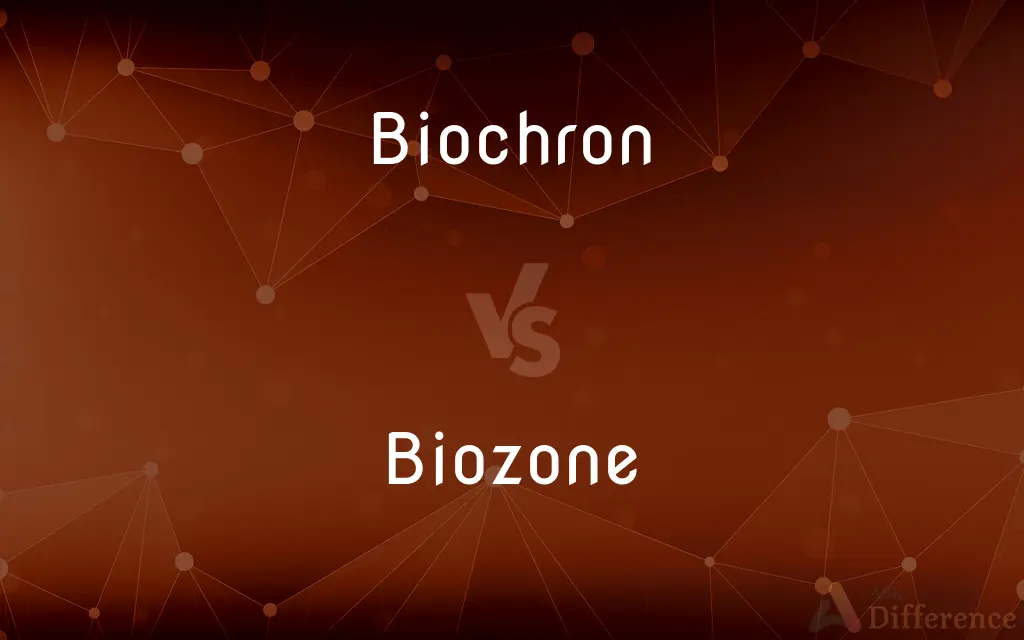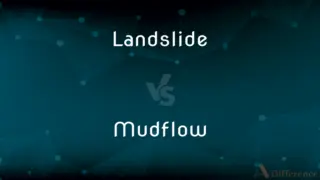Biochron vs. Biozone — What's the Difference?
Edited by Tayyaba Rehman — By Maham Liaqat — Updated on April 16, 2024
Biochron refers to a time interval defined by the range of certain fossils, while a biozone represents a stratigraphic unit identified by a specific fossil or group content.

Difference Between Biochron and Biozone
Table of Contents
ADVERTISEMENT
Key Differences
Biochrons are defined by the temporal distribution of specific fossils across geological layers, primarily used to indicate time intervals in paleontology. Whereas biozones are designated as stratigraphic units within rock layers, characterized by the presence of particular fossils or fossil assemblages.
Biochrons help in understanding the chronological arrangement of geological events by using widespread or rapidly evolving species as markers. On the other hand, biozones provide insight into the environmental and geographical conditions of past eras through localized fossil findings.
The concept of a biochron is often utilized in biostratigraphy to correlate age across different geographic locations using similar fossil records. Whereas a biozone is used to identify and correlate layers within a specific location or region, helping geologists map out the earth's historical strata.
Biochrons can span various geographical regions, indicating broader time frames that encompass multiple biozones. In contrast, biozones may cover narrower areas and are specific to certain layers or formations within a region.
Biochronology requires a comprehensive understanding of fossil distribution and evolution over time to accurately define time intervals. Whereas biozone classification focuses more on the presence and abundance of key fossil groups within specific strata, often leading to more precise local stratigraphic delineations.
ADVERTISEMENT
Comparison Chart
Definition
A time interval defined by the fossil range.
A stratigraphic unit marked by specific fossils.
Purpose
Used to correlate geological age across different areas.
Used to identify and correlate layers within a region.
Scale
Broad, can be global.
Localized to specific strata or formations.
Dependency
Relies on widespread fossil evidence.
Depends on the presence of particular fossils.
Application in Science
Important in biostratigraphy and paleontology.
Critical in detailed stratigraphic mapping.
Compare with Definitions
Biochron
A chronological measurement based on fossil distribution.
Scientists used biochrons to date the sediment layers.
Biozone
A layer of rock defined by a distinctive group of fossils.
The biozone containing ammonites helps identify the Cretaceous period.
Biochron
A paleontological term for dating geological periods.
Biochrons help decipher earth’s history through fossils.
Biozone
A stratigraphic unit used in geological mapping.
Geologists mapped the area using biozone markers.
Biochron
A time span characterized by specific fossil content.
The Permian biochron is marked by the widespread presence of trilobites.
Biozone
A classification based on the fossil content of a region.
The biozone method refined our understanding of local stratigraphy.
Biochron
A method of correlating geological events over time.
The biochron of these fossils suggests a Jurassic age.
Biozone
A geological marker for environmental and geographical conditions.
This biozone indicates a marine environment.
Biochron
An interval of geological time defined by fossil evidence.
The dinosaur biochron provides insights into their era.
Biozone
A unit in paleontological studies for specific fossil assemblages.
The biozone analysis revealed diverse ancient species.
Biochron
A biochron (from the Greek bios, life; and khronos, time) is the length of time represented by a biostratigraphic zone. Biochrons are named after characteristic fossil organisms or taxa that characterise that interval in time.
Biozone
In biostratigraphy, biostratigraphic units or biozones are intervals of geological strata that are defined on the basis of their characteristic fossil taxa, as opposed to a lithostratigraphic unit which is defined by the lithological properties of the surrounding rock. A biostratigraphic unit is defined by the zone fossils it contains.
Biochron
The length of time represented by a biozone
Biozone
(geology) A biostratigraphic unit: an interval of geological strata defined on the basis of its characteristic fossil taxa.
Biozone
(ecology) An ecozone.
Common Curiosities
Can a biochron overlap multiple biozones?
Yes, a biochron can span multiple biozones, reflecting broader time frames.
How do biochrons aid in paleontology?
Biochrons help correlate geological events and ages across different locations based on fossil evidence.
How is a biozone identified?
A biozone is identified by the presence of specific fossils or fossil groups in a stratigraphic unit.
What is the primary use of biozones?
Biozones are primarily used for detailed stratigraphic mapping within specific regions.
What kind of fossils define a biochron?
Fossils that are widespread and rapidly evolving are often used to define biochrons.
Why are biozones important in geological studies?
They allow geologists to precisely identify and correlate specific layers or formations.
What role does biochronology play in understanding Earth's history?
It provides a timeline based on fossil records, aiding in the reconstruction of Earth's past environments.
What defines a biochron?
A biochron is defined by the chronological range of specific fossils across geological formations.
Is there a difference in the scale of study between biochrons and biozones?
Yes, biochrons usually pertain to broader, often global scales, while biozones are more localized.
Are biozones applicable globally?
Biozones are generally more localized and not typically used for global correlations.
Can biozone classifications vary between regions?
Yes, biozone classifications can vary depending on the local fossil assemblages found.
What tools are used to identify biozones?
Stratigraphic mapping and fossil analysis are key tools in identifying biozones.
Can the same fossil be used to define both a biochron and a biozone?
Yes, the same fossil can sometimes define both, depending on its geographical spread and stratigraphic occurrence.
How specific is the dating with biozones?
Dating with biozones can be highly specific to particular geological formations.
How do researchers determine the boundaries of a biochron?
Boundaries of a biochron are determined by the first and last appearance of key fossils.
Share Your Discovery

Previous Comparison
Landslide vs. Mudflow
Next Comparison
Minix vs. UnixAuthor Spotlight
Written by
Maham LiaqatEdited by
Tayyaba RehmanTayyaba Rehman is a distinguished writer, currently serving as a primary contributor to askdifference.com. As a researcher in semantics and etymology, Tayyaba's passion for the complexity of languages and their distinctions has found a perfect home on the platform. Tayyaba delves into the intricacies of language, distinguishing between commonly confused words and phrases, thereby providing clarity for readers worldwide.















































